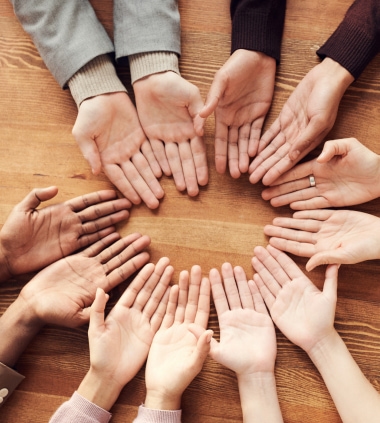The SANCTUARY Model®
What is Sanctuary?
In 2021, CenClear was recognized by the Sanctuary Institute@ for its committment to the Sanctuary model.
The Sanctuary model was developed to recognize the many people who have been exposed to trauma and the impact that can have on their quality of life. To become certified an organization works with clients, employees and board members to implement this model. We understand that adversity and trauma can impact our behavior. The Sanctuary Model@ works to create a safe environment where clients and staff learn to adjust behaviors to help themselves and other heal from adverse experiences.
Creating Safer
Organizations
The Sancturary Model is a nationally recognized plan for trauma-informed care. CenClear applies Sanctuary principles as the basis for our programs and to guide our staff to share the same values and language. As a result, we have a safer organization that is focused on growth and change.
“The Sanctuary Model® is an organizational and treatment intervention based on the tenants of trauma theory. It addresses the ways in which trauma, adversity and chronic stress influence individual behavior as well as recognizes the ways in which whole organizations can be influenced by trauma, adversity and chronic stress.”
When we practice Sanctuary, we are being mindful that others may have experienced trauma, and we act in ways that don’t re-traumatize or recreate the trauma in their lives. We also practice self-awareness and recognize the ways that our own past trauma may influence how we communicate and act with others so that we can work to make changes that help us to have healthier relationships with others.
We practice the 7 Commitments to guide our behaviors and communication (both verbal and nonverbal—for example, body language, eye contact, facial expressions). We use the S.E.L.F. model and Sanctuary Toolkit to learn new ways of doing, speaking, and being with each other to improve self-awareness, communication, and safety.
What is the S.E.L.F. Model
(A shared language)?

A framework for focus and intervention with clients, families and our organization. Discuss the situation within the following 4 areas:
S – Safety (physical, psychological, social and moral) - Safety allows us to manage our emotions well.
“Joe is feeling emotionally (psychologically) unsafe in his current relationship. He says his partner says things to him that make him feel like he’s a child again.”
E – Emotions (recognize and handle feelings in non-harmful ways) - Emotional Management allows the expression of loss.
“Joe stops speaking to his partner when he feels he’s not being heard or respected. He says he feels like nothing will ever change.”
L – Loss (acknowledge and grieve past loss, commit to move forward, understand all change involves loss) - Loss allows us to think about our future.
“Joe has had a string of bad relationships and doesn’t get to see his older child often. He’s afraid that will happen again if he leaves the relationship.”
F – Future (re-establish the ability to choose and engage in new behaviors, instead of repeating old patterns) - Creating our own Future allows us to create a safe one.
“Joe wants to learn how to communicate better—more directly and without feeling defensive. He doesn’t know if this will save his current relationship, but he thinks this will help him in all areas of his life.”
What are the 7 commitments
(Organizational Values)?

Non-violence
Being safe outside (physically), inside (emotionally), with others (socially), and doing the right thing (morally) Non-violence is not just causing or trying to cause physical harm to others or ourselves. Speech and body language can be considered violent. We do our best to choose our words so that they don’t hurt others, and we refrain from using our bodies and movements to intimidate others.
Emotional Intelligence
Managing our feelings so that we don’t hurt ourselves or others. Learning to take a time-out to process feelings is a good way to practice emotional intelligence. Learning coping skills that we can do in the moment is good for those times we cannot take a time-out.
Social Learning
Respecting and sharing ideas. We practice listening to each other and having the courage to share our own thoughts and ideas.
Democracy
Shared decision making. Service and treatment decisions should be made with input from all the members of the team.
Open Communication
Saying what we mean and not being mean when we say it. We should speak directly and with respect.
Social Responsibility
Together we accomplish more, everyone makes a contribution to the organizational culture. We must do what we say we’re going to do and ask for help when we need it. When everyone pitches in, no one person is left doing all the work.
Growth & Change
Creating hope for our clients and ourselves. To keep from being stuck in one place, we review and revise goals often. As an agency, we review old policies to make sure they still apply as our culture changes.
What are the tools in the
Sanctuary Toolkit
(the practical tools)?
Community Meetings: How are you feeling today? What is your goal for the day? Who can you ask for help?
Professional Quality of Life Scale (ProQOL): measures compassion satisfaction, burnout, and secondary trauma
Safety Plan: list of activities to choose from when feeling overwhelmed to avoid engaging in unsafe behaviors
Psychoeducation Groups: tool to teach clients about trauma and strategies to promote success in the S.E.L.F. components
Treatment Planning Conference (TPC): tool for measuring client growth and change using the S.E.L.F. framework to organize conversation and documentation; involves as many team members as possible
Team Meeting: all participants are engaged and contribute, start with community meeting; focus on clients, new ideas or initiatives, and staff or community issues
Red Flag Meeting/Review: short meetings to address critical incidents or to identify possible collective disturbances
Self Care Plan: these are things that you do for YOU to stay well and is different from a Safety Plan in that they are to be practiced regularly and proactively rather than as an in the moment intervention
Contact Us
For more information call us: 1-800-525-5437
